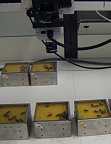Behavioural defence of honeybees against Nosema ceranae

Honey bees, as eusocial organisms, possess high interaction rates. To avoid the expected increased parasite infestation honey bees evolved several behavioural and organisational defence mechanisms. One group of their diverse parasites is the Microsporidian Nosema ceranae. In this study we demonstrate that the interaction frequency and the behaviour towards N. ceranae infected honey bees are distinct to healthy nest mates. A behaviour assay was designed in which groups of honey bee workers were recorded several days and contacts of N. ceranae infected honey bees and non-infected controls with their nest mates were counted. In every experimental replicate the infected bee received more contacts than the uninfected control bee. This interaction ratio increased for the infected bee over time. A high proportion of the infected bees died as a consequence of continuous attacks by nest mates. Additionally no evidence for parasite transmission was found within in the group. Hence, behavioural modulation of healthy bees towards infected ones seems to benefit the honey bee at the group level rather than the parasite.
Experimental evolution in Nosema ceranae
The honeybee, Apis mellifera, and its Microsporidian parasite, Nosema ceranae, where used to test the short-sighted evolution hypothesis in an infection experiment. We studied if transmission of N. ceranae can show a response to selection, and whether virulence trades off against transmission. N. ceranae spores where selected for survival outside the host organism as a fundamental attribute for transmission. After several weeks of exposure to drought, spore survival and infectivity where heavily reduced in infection of workers. In a subsequent infection with freshly produced spores from the previous infection, the selected Nosema strains showed a highly significant increase in virulence within newly infected honeybee workers. We discuss this result in light of the evolutionary theory.
Comparison of colony health in wild and managed honeybees
Apiculture is assumed to increase colony density and to reduce genetic diversity and therefore promote pathogen transmission. To investigate this hypothesis it is necessary to compare the health status of truly wild honey-bee populations with managed ones. In this study we screened several honeybee populations of South Africa for prevalence of six different viruses. We used a new diagnostic MLPA tool (Multiplex Ligation-dependent Probe Amplification, “Beedoctor”, de Smet et al. 2012) to test bees from nature reserves and apiaries. Furthermore we determined population genetic parameters to assess genetic diversity of these populations. Despite of a higher genetic diversity managed honeybee population had higher rates of infections compared to the wild population. Thus the high colony density at apiaries which makes it easier for pathogens to spread seems to nullify the advantage of a higher genetic diversity.
